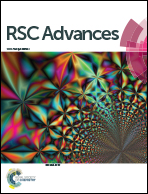Facile synthesis of urchin-like CsxWO3 particles with improved transparent thermal insulation using bacterial cellulose as a template
Abstract
Urchin-like CsxWO3 particles were synthesized using bacterial cellulose (BC) as a template by the hydrothermal method. The effects of the BC addition amount on the morphology, W5+ content and transparent thermal insulation of CsxWO3 were studied. It has been confirmed that abnormal growth of CsxWO3 rods was greatly reduced after introduction of BC into the precursor solution. Moreover, introduction of BC into the precursor solution could significantly improve the transparent thermal insulation properties of the CsxWO3 film. In particular, when the BC amount was appropriate, the prepared CsxWO3 film exhibited better visible transparency, with the visible light transmittance (TVis) more than 60%. In addition, the urchin-like particles could be transformed into small size nanorods after H2 heat-treatment, exhibiting excellent visible light transparency and thermal insulation performance. In particular, it has been proved that the 20BC-HT-CsxWO3 film exhibits excellent thermal insulation performance, and shows broad application prospects in the field of solar heat filters and energy-saving window glass.



 Please wait while we load your content...
Please wait while we load your content...